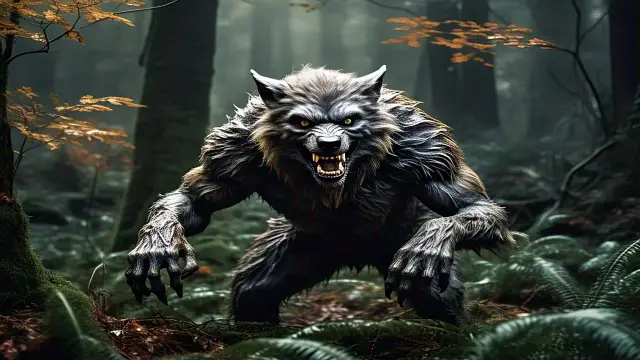Let me take you back to June 1764, to the rolling hills and dense forests of Gevaudan in southeastern France. Picture this: a young woman tending her cows, the sun dipping low, when suddenly, a monstrous creature emerges from the shadows. It’s the size of a donkey but looks like a wolf—if wolves had nightmares about other wolves. Her dogs bolt in terror, but the cows, bless their brave hearts, stand their ground and chase the beast away with their horns.
This was the first recorded sighting of what would become known as the Beast of Gevaudan. And while this woman escaped unharmed, many others weren’t so lucky. Over the next three years, this creature would terrorize the region, leaving a trail of blood, fear, and unanswered questions.
The First Attacks
The beast’s reign of terror began in July 1764, when a young girl was found dead, her heart ripped out. Yes, you read that right. Ripped out. Over the following months, the attacks escalated. Men, women, and children were savaged, their bodies mangled beyond recognition. The beast showed no fear, attacking even groups of armed men.
By this point, the locals were convinced they were dealing with a loup-garou—a werewolf. And honestly, who could blame them? The descriptions of the creature were straight out of a horror story: taller than a wolf, with reddish fur, talon-like claws, and a mouth full of razor-sharp teeth.
The Hunt Begins
The Paris Gazette published detailed accounts of the beast, and soon, the story spread like wildfire. Even the English St. James Chronicle weighed in, suggesting the creature might be some kind of hybrid—a mix between a hyena and a tiger. But here’s the thing: hyenas and tigers aren’t native to France, and they can’t interbreed. So, what was this thing?
The attacks became so frequent and brutal that the villagers appealed to King Louis XV for help. The king sent Captain Duhamel and a troop of light cavalry to hunt the beast. Some soldiers even dressed as women, hoping to lure the creature out. (Spoiler: it didn’t work.)
Despite their efforts, the beast always seemed to escape. Duhamel eventually returned to Versailles, convinced the creature was dead. But the killings continued.
The Silver Bullet
By 1767, the situation was dire. Entire villages were abandoned, and people were too scared to leave their homes. Enter Jean Chastel, a local hunter who believed the beast was no ordinary animal. He loaded his rifle with silver bullets—because, apparently, he’d read enough folklore to know how to deal with supernatural creatures.
On June 19th, the beast charged at Chastel and his hunting party. He fired twice, and the second shot pierced its heart. When they gutted the creature, they found human remains inside its stomach, including the collar bone of a young girl.
The beast was dead, but the mystery was far from solved.
What Was the Beast of Gevaudan?
Let’s break this down. Over the course of three years, the beast killed around 60 people and injured countless others. The French government spent a fortune—29,000 livres, to be exact—trying to stop it. But what exactly was it?
- A Mutant Wolf? Some experts suggest it could have been an unusually large or aggressive wolf. But wolf attacks on humans are incredibly rare, and this creature’s behavior was anything but typical.
- A Werewolf? The locals certainly thought so, and there are historical records of people confessing to being werewolves. But those cases involved humans transforming into wolves, not a beast that remained in wolf form.
- Something Else Entirely? The descriptions of the creature—its size, its talons, its strange appearance—don’t match any known animal. This has led some to classify the Beast of Gevaudan as a cryptid, a creature whose existence is disputed or unproven.
The Aftermath
After the beast was killed, its body was paraded around Gevaudan for two weeks before it was supposed to be sent to Versailles. But here’s where things get even murkier. Some accounts say the carcass began to rot and was buried in the countryside. Others claim it was burned or even stuffed and mounted before mysteriously disappearing.
Personal opinion: I’m convinced the Beast of Gevaudan was more than just a wolf. The sheer number of attacks, the descriptions of the creature, and the fact that it took a silver bullet to bring it down all point to something far stranger.
Why Does This Matter?
The Beast of Gevaudan isn’t just a historical curiosity; it’s a reminder of how fear and mystery can shape our understanding of the world. In an age before DNA testing and forensic science, people turned to folklore and superstition to explain the unexplainable.
And let’s be real: even today, with all our technology and knowledge, there are still things we can’t fully explain. Maybe that’s why stories like this continue to captivate us.
Final Thoughts
So, what was the Beast of Gevaudan? A mutant wolf? A werewolf? A cryptid? We may never know for sure. But one thing’s certain: this story has all the elements of a gripping tale—mystery, horror, and a touch of the supernatural.
If you’re as fascinated by this as I am, stay tuned. In a future article, we’ll dive into the werewolf trials and explore whether there’s any truth to the legends.
Source: Jerome Clark, Unexplained!
For more on cryptids, check out cryptidarchive’s guide to mysterious creatures. https://cryptidarchives.fandom.com/wiki/Mysterious_Creatures:_A_Guide_to_Cryptozoology
Interested in werewolf lore? Here’s a deep dive into the history of werewolf trials.
What do you think the Beast of Gevaudan was? Drop your theories in the comments—I’d love to hear them!

